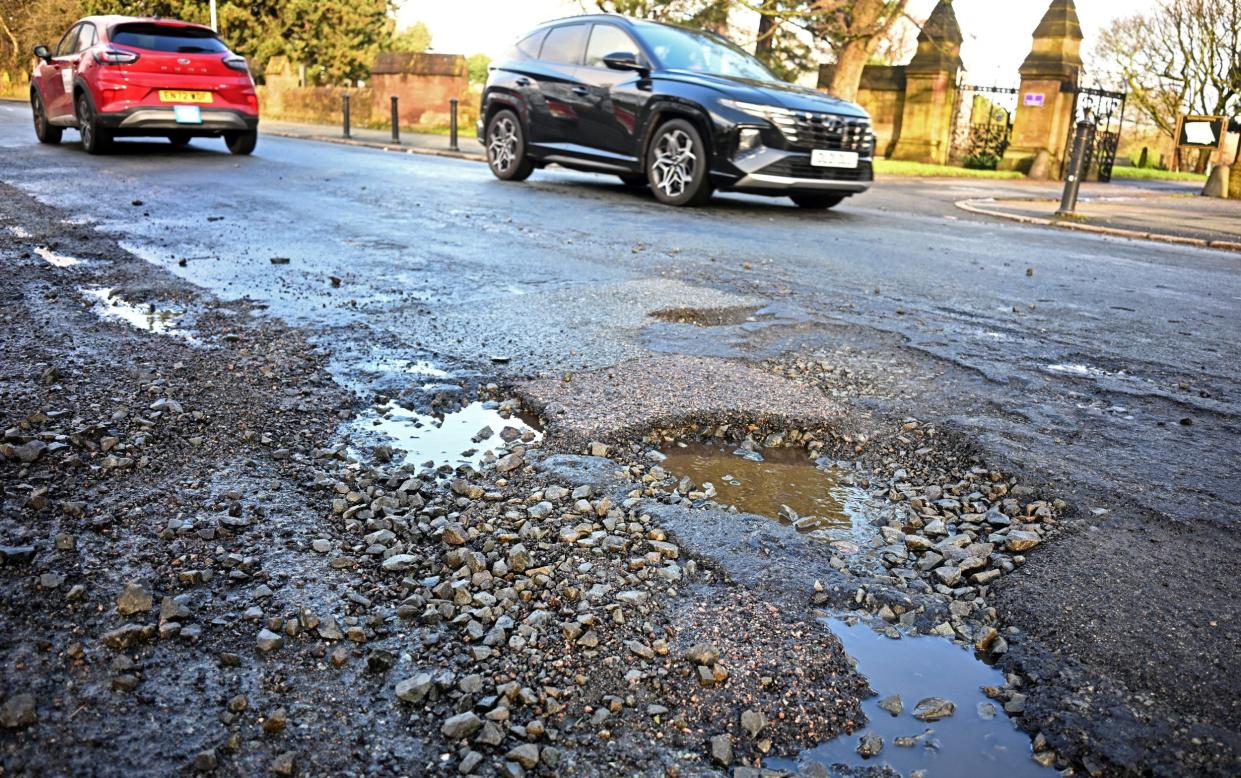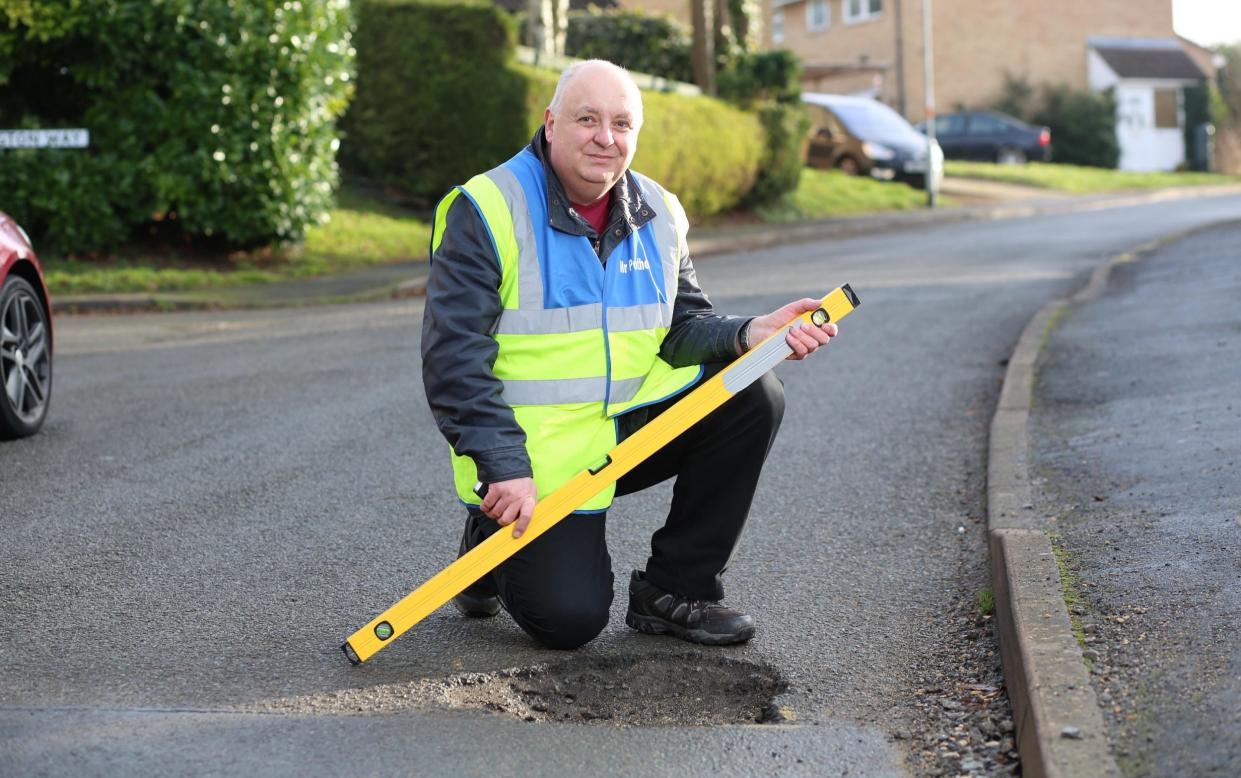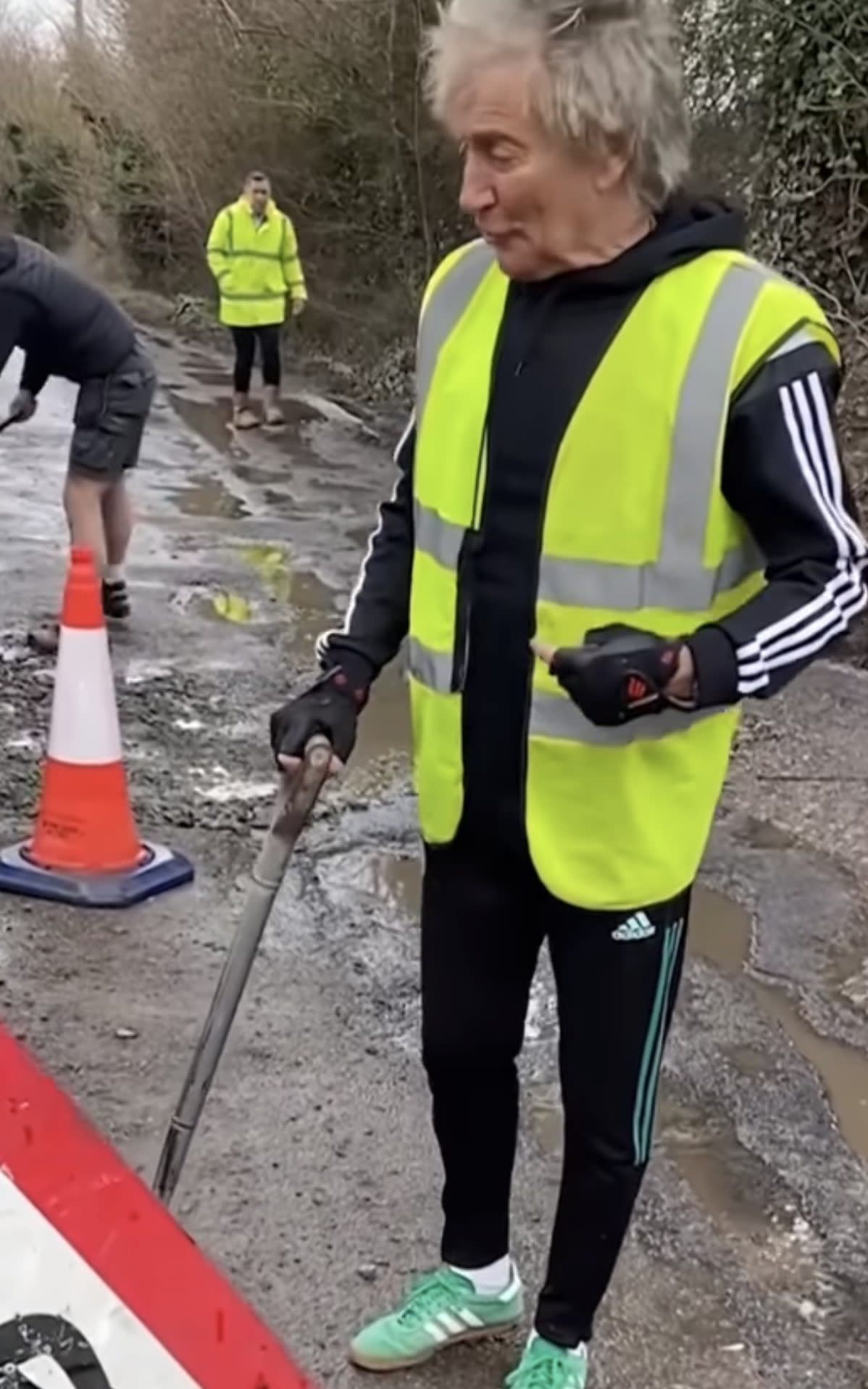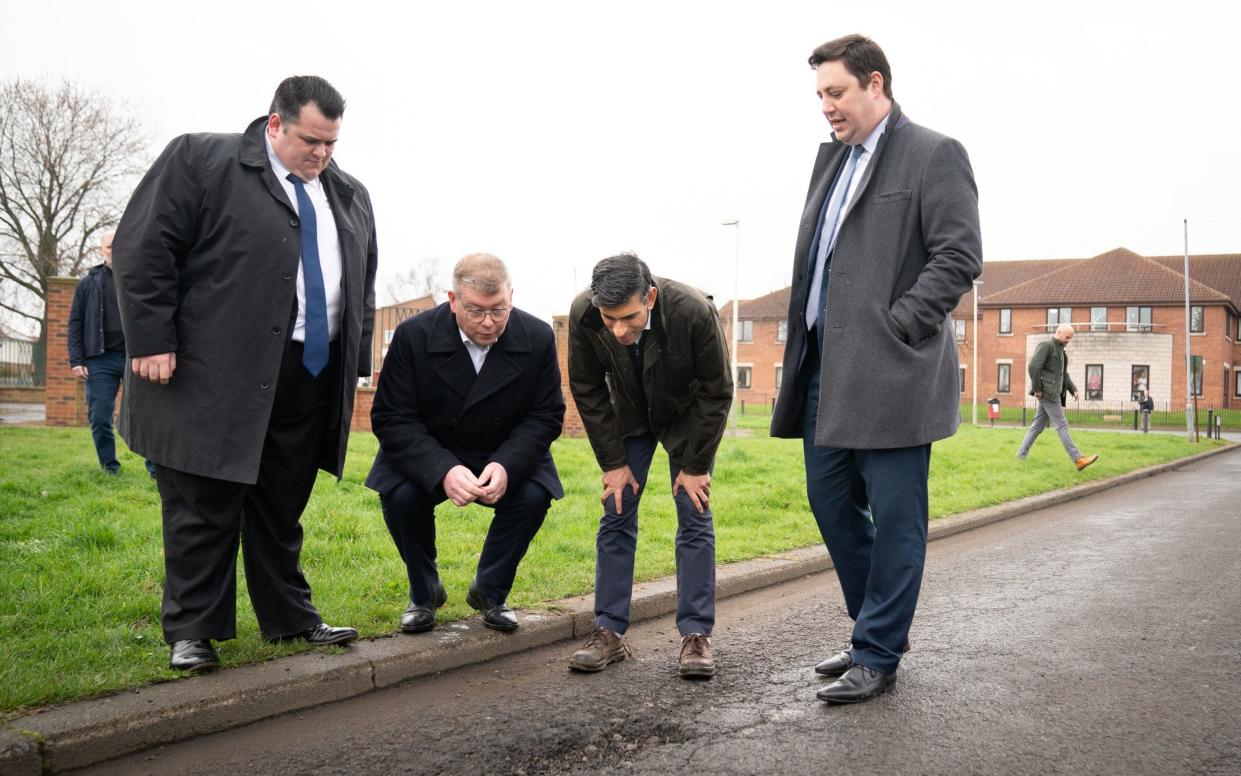Why Britain has failed miserably to solve its potholes crisis – and how to fix it

This is the first in a series of articles, each of which will take an in-depth look at the failing institutions, infrastructure and other parts of the public sector that typify the idea of ‘Broken Britain’
On an overcast day earlier this month, Mark Morrell was standing on Kingsley Road in Silverstone, Northamptonshire, surrounded by a film crew and pointing to a stretch of the street that has been repaired so many times it resembles a cross between a patchwork quilt and a lunar landscape.
It was all in a day’s campaigning for the former utility engineer, who is widely known as Mr Pothole and has been making as much noise as possible about the parlous state of Britain’s roads for the best part of 12 years. But this time there was a twist.
Morrell’s crusade began when his then-teenage daughter, who had just passed her test, became worried drivers were swerving towards on-coming traffic to avoid a pothole near their home. Morrell complained to the council, got nowhere and eventually informed the police, “which is, in reality, the only way you’re going to get an emergency repair done these days,” he says.
He started small with a Facebook page but clearly has a gift for publicity: early on he baked a birthday cake for a pothole that hadn’t been fixed by the local council for more than a year. The stunt caught on elsewhere in the country and Morrell’s national profile grew as the state of Britain’s roads deteriorated.

But this time the film crew was from state-owned FranceTV, our cross-Channel neighbour’s equivalent of the BBC. That’s right, the utterly calamitous state of Britain’s roads is no longer merely a national embarrassment; the humiliation is about to go global.
Perhaps the only surprise is that it took other countries so long to notice. The UK’s road quality ranks just 37th in the world – a bit better than Lithuania, a bit worse than Slovenia. But those French television producers clearly know a good metaphor for modern Britain when they drive over one (and top marks for irony to the producer who decided to film the segment in the town that hosts the British Grand Prix).
Our most visible crisis
Britain can boast cutting-edge capabilities in areas such as artificial intelligence, pharmaceutical innovation, finance, filmmaking and even some aspects of car manufacturing. And yet this country doesn’t build enough houses and its roads are falling apart; modern Britain is an advanced society that is immiserating itself through poor land use and inadequate infrastructure.
A lot of the UK’s problems – long NHS waiting times and crumbling schools, for example – are huge issues for those directly affected but can be somewhat abstract to the general public. There is, however, no hiding the state of Britain’s crumbling roads. Michèle Dix, a former managing director for planning at Transport for London and now a commissioner at the National Infrastructure Commission (NIC), says the state of the UK’s roads highlights broader neglect of our transport links. Too often the focus and funding gets directed at building something new rather than maintaining something old, she argues.
Potholes have always been with us; some historians believe the term dates back to potters digging out the clay that formed the base of Roman roads. But the situation has never been worse. There was a 62 per cent increase in the number of potholes recorded by councils in Britain last year, according to analysis conducted by the pressure group Round our Way based on Freedom of Information requests.
The AA dealt with more than 630,000 pothole-related incidents in 2023, up 16 per cent on the previous year. The damage to cars is estimated to have added up to nearly £480 million last year alone. The Asphalt Industry Alliance’s (AIA) aptly acronymed Annual Local Authority Road Maintenance survey calculated that the amount of money needed to fix the backlog of problems on local roads has now reached a cool £16.3 billion, a 16 per cent increase from last year.
Public ire
No wonder the nation’s road users are so angry. Photos of stony-faced motorists pointing at asphalt cavities have become a mainstay on the front pages of local newspapers. Politicians gather around in high-vis jackets, stroking their chins and staring into grimy puddles as if they are font of all human knowledge. Last year the bonfire society in Lewes, East Sussex, famous for its topical effigies, burned “Pothole Pete”, who was dressed as “an indistinguishable civil servant”, on Guy Fawkes night.
A few months earlier, Sir Rod Stewart was spotted raking gravel after struggling to drive his Ferrari down a road near his house in Harlow, Essex. In many parts of the country local residents have started putting down their own traffic cones to warn drivers about the most dangerous potholes. In Lostwithiel, Cornwall, a “phantom filler” has started taking matters into his own hands and is fixing roads under the cover of night.

“People have had enough,” says Morrell. “There’s long been plenty of anger about potholes, but now it’s reaching boiling point. People spend a fortune on fuel duty and road tax but the problem just gets worse.”
The issue was brought into sharp focus earlier this month when it emerged that police were investigating whether an accident that resulted in the death of a 74-year-old Porsche driver was caused by the man swerving to avoid a pothole, near the Sussex village of Petworth. Elsewhere, residents of Charlton-All-Saints near Salisbury, Wiltshire have been left with only one way in and out of their hamlet after a pothole the length of a double-decker bus opened, rendering a road unusable.
All this ire is a particular problem for the Conservatives. Many of the party’s traditional supporters live in the countryside and rely on cars to get around. Scores of Northern “Red Wall” seats the Tories won in the 2019 election are located in some of the most pothole-blighted parts of the country. The state of Britain’s roads has become a key issue on the doorstep and Labour was punching the bruise in the lead up to the local elections, with claims there are 100 times more potholes on British roads than craters on the Moon.
The Tories have long been alive to the danger. Three years ago Rishi Sunak promised to fill in 50 million potholes. Last year, he earmarked £8.3 billion of the money saved from scrapping the northern leg of HS2 to fix roads. Esther McVey recently said this was “the biggest ever funding increase” for road improvement. “We’ve given councils the cash to fix potholes,” the minister without portfolio/for common sense wrote in The Telegraph. “Now they need to get on with it.”

Scale of the problem
Clearly, £8.3 billion is a lot of money and motoring groups are broadly agreed it will make a big difference. But they also say it must be put in context. By McVey’s own admission, the extra HS2 money will only pay to resurface around 5,000 miles of road, which is just 3 per cent of all council-managed roads in England, and will be dripped out over the course of 11 years. The trouble is, the AIA believes that around 107,000 miles of roads, about 53 per cent of the total network, will reach the end of their structural lives within the next 15 years.
“The scale of the problem now facing councils is truly gargantuan,” says Simon Williams, the RAC’s head of policy. “The status quo is not sustainable. The longer the Government fails to grasp this reality, the bigger the eventual cost to the public purse.” When it comes to this nation’s roads, the UK failed to fix a stitch in time and is now left holding a bill for nine.
It’s still worth doing though. The UK’s pothole epidemic is costing the economy £14.4 billion a year, according to the first analysis of its kind conducted by the Centre for Economics and Business Research (CEBR). This took into account the damage to vehicles, accidents, extra emissions and more than 1.3 billion hours in additional journey time as the result of bad roads.
Douglas McWilliams, the economist who conducted the research for the CEBR and recently completed the Peking-to-Paris car rally, says: “My take is that our roads are now worse for potholes than anywhere on that rally, apart from the far west of China and Mongolia, and notably worse than in both Russia and Kazakhstan – let alone western Europe.”
How did it get this bad?
We motorists tend to think of roads as horizontal. But from an engineering point of view they are very short and extremely wide vertical structures. Take a cross section of your local road and you’d see three distinct layers. At the bottom is the compacted subgrade soil. The middle layer, or road base, is graded gravel that will likely have been mixed with cement. On top is a covering of permeable asphalt.
That all sounds relatively simple, but there can be quite large variation in both the quality of the materials and techniques used to build the roads. And, according to Dr Benyi Cao, a research fellow at the Royal Academy of Engineering, the UK has quite the reputation for scrimping on both compared with other European countries.
For example, after compacting the subgrade level, road builders will conduct quality control for water content to ensure that the base is neither too wet nor too dry. But there’s a big difference in testing every few hundred metres, which Cao says would be considered best practice, and every mile or so, as sometimes happens. Similarly, if the road base isn’t thick enough it will be more prone to flexing, resulting in cracks quickly appearing on the surface. Lower quality bitumen will become brittle more quickly.
Morrell, who worked in the utilities industry for 25 years before becoming a campaigner, has seen first-hand how road-building standards have slipped. “When I had to dig up roads in London that were built 50 or 60 years ago it would break my heart. Those guys knew how to build roads that would last.”
Potholes start to develop because fatigue cracking, ageing asphalt and/or poor drainage results in water entering and remaining in the subgrade and base layers. The weather obviously presents its challenges. As you may have noticed, it rains a lot in the UK. Surface flooding is getting worse because of “urban sprawl”, poorly maintained drains and climate change. The temperature also bounces around 0C (32F) for months at a time, creating a continuous freeze-thaw cycle during which water will repeatedly expand and contract, forcing cracks farther apart.
British roads are also among the busiest in the world. Lots of freight travels by lorry or van because the rail network is so unreliable. We’re buying increasing numbers of SUVs and electric cars, which are heavier and therefore put more stress on the roads. Research by University College London suggests that the increasing reliance on satnavs is resulting in heavier traffic on minor country roads and urban “rat runs”.
The UK also has more ducts and pipes carrying our gas, electricity, water and broadband laid under the roads than in other countries. Frequent excavations by utility companies and their poor-quality repairs further diminish the integrity of the carriageway. Some 55 per cent of all potholes in urban areas are caused by utilities digging up the roads.
Responsibility shifted to utility firms
Part of the issue is a little-known change in the law in 1991. Prior to this, companies had to pay highway authorities to repair roads after they’d been dug up. Westminster council charged £120 per square metre for this work. But under the New Roads and Street Work Act of 1991, utilities could reinstate their own openings. Costs dropped to an estimated £40 per square metre.
In theory the savings should have resulted in lower bills (or fatter margins for the utility companies). But the change in the law clearly had a number of unintended consequences. First, utility companies became less hesitant about digging up roads. Second, it was clearly in their interests to repair the damage they caused as cheaply as possible. And, third, the councils lost an important source of revenue that many in the industry believe was subsidising their other road maintenance work.
Politicians are now having to deal with the fallout. When he was transport secretary, Chris Grayling promised to make utilities put their pipes under pavements rather than roads – until it was quietly pointed out that utilities would love to do that, because it would vastly improve access, but unfortunately there’s not enough space. Grant Shapps, one of Grayling’s successors, threatened to slap companies that bodge their repairs with financial penalties. But this relies on councils having enough inspectors to assess the work. And, because of budget cuts, many don’t.
Funding shortfalls
Successive governments have been squeezing local authority budgets for decades. Statistics from the Covid years can be fairly misleading. But the trends from before the pandemic tell a clear tale. Central government grants to local authorities have collapsed from £46.5 billion in 2009/10 to £28 billion in 2019/20 in today’s prices, according to the Institute for Government.
Part of this 40 per cent drop was offset by increases in council tax. But even when this is taken into account, local authorities are staring down the barrel at an average funding shortfall of nearly 18 per cent. Many have understandably prioritised schools and children’s social care, meaning the axe has fallen particularly hard on things such as road maintenance.
“Roads don’t collapse dramatically, they just progressively get worse and worse, so it is easier to kick the can down the road a bit farther when times are hard,” Rick Green, the chairman of the AIA, told The Telegraph last year. This is precisely what’s happened.
Recent analysis by the Local Government Association (LGA) found that this reduction in funding to repair local roads was bigger than in almost every other country in the Organisation for Economic Co-operation and Development club of wealthy nations, resulting in the UK falling from “top to almost bottom of the league” over two decades, according to Shaun Davies, the chairman of the LGA. Only Italy and Ireland had cut their budgets by a similar amount over that time, while the United States, Japan, New Zealand, Sweden and Denmark had all increased theirs by more than half.
There are various ways to crunch the numbers on this. Despite the Government’s claim that the £8.3 billion diverted from HS2 would pay for the resurfacing of 5,000 miles of road, we know that just 1,123 miles of road were resurfaced in the 2021/22 financial year, compared with 1,588 miles in 2017/18, according to research conducted by the RAC based on government data. That’s a drop of 29 per cent. Multiply that by 11 and you get 5,115 miles – more than the HS2 money will pay for.
Or you can look at the combined annual funding shortfall in the road maintenance budgets of local authorities in England and Wales. This now adds up to £1.3 billion, according to the AIA. If you again multiple that number by 11 you get to a figure of £14.3 billion. So, even with the HS2 money added to the pot, there’s still a £6 billion gap.
“The Government is pushing this narrative of record investment in our roads,” says one transport expert. “But it doesn’t make up for the cumulative cuts in funding that have been made over the years.”
Inadequate fixes
The result has been an over-reliance on patching potholes and making repairs rather than resurfacing roads, says Dix. Again, this can be done badly or well. The quickest and cheapest method involves shovelling cold-lay Tarmac into a hole, which workmen then, in the words of Morrell, “tread down with their size nines”. Using hot Tarmac is marginally better. Cutting out a section of the road and then compressing hot Tarmac into the neat hole is best.
But if a pothole has formed, it almost certainly means the integrity of the road surface is already compromised. It will therefore only be a matter of time before the repair wears out or a new hole appears close by. The AIA likens patching to “icing a rotten cake”. Edmund King, the president of the AA, says: “Currently we often have a vicious circle of pothole formed, damage caused, pothole patched, pothole reappears with more damage caused – when what we need are more permanent repairs.”
What’s to be done? The NIC has recommended councils outside London receive five-year budgets for road maintenance and that total funding be increased from £6.5 billion a year to £8 billion. The RAC has also been calling for a fundamental overhaul in how road maintenance is funded, perhaps by ring-fencing a proportion of the money the Treasury raises from fuel duty. Both proposals would provide councils with the longer-term certainty needed to better plan programmes rather than having to cope with “boom and bust” funding cycles.
New technology
Researchers are working on innovative solutions to our pothole problems. Rubberised asphalt, for example, adds shredded tyres to the bitumen mix in order to make the road surface more elastic and stop it cracking so easily. Some councils are already experimenting with adding a graphene-based material to asphalt. This is about a fifth more expensive but lasts twice as long.
A company called Roadmole makes a remote-controlled contraption that cuts circular sections out of the road surface around potholes rather than the usual squares, whose corners can become weak points for water seepage. The JCB Pothole Pro can fix a pothole in just eight minutes at a cost of £30. Stoke-on-Trent City Council’s highways team is the first in the country to use this bit of kit and is already exceeding its repair targets.
The Nu-phalt Thermal Road Repair heats up a damaged patch of the road to recycle existing macadam and ensure it bonds better with new material. Then there’s the Kiely Multipatcher from Australia, which needs only one person to operate it, combines pothole repair with small-scale surface dressing, and can mend about 100ft of road in under three minutes.
More Tomorrow’s World solutions include a “self-healing” asphalt with steel fibres and epoxy capsules infused in the materials that repairs itself when heat is applied. Capsules containing bacteria can also be added to cement-based road materials. When they crack, the bacteria are released and start producing calcite (a form of limestone) as a natural byproduct of their metabolism.
Cao is experimenting with using ground-source heating and cooling systems to help regulate the temperature of the road surface to stop it melting in the summer and to break the freeze-thaw cycle in the winter.
However, Dix warns that the authorities need to remain mindful of more basic fixes. “There are lots of things we can do [to prevent potholes], but digging drains by the side of the road should be first on the list,” she says.
Whether the solutions are cutting edge or more rudimentary, they all cost money. There’s not a lot of that to go around at the moment. But the alternative is, well, just take your car for a drive, your bike for a ride, or tune in to French television, to see what systematic under-investment looks like.
Your input will shape how we report on this series. Please use the form below to send us your stories of Broken Britain and what other parts of our fractured institutions we should be shining a light on. Click here for our report on the IT systems crippling the NHS.
Next week, we tackle the UK’s low wages crisis, including how the tax system is encouraging some workers to keep their pay artificially low to avoid crossing thresholds that would result in higher bills. Share your stories below...


